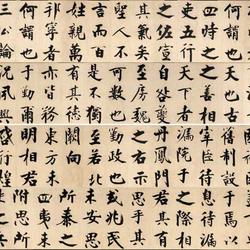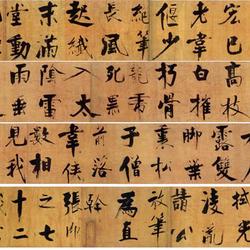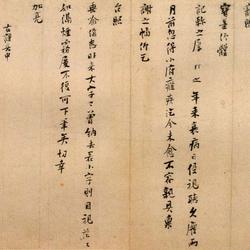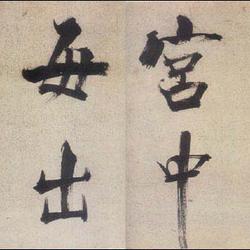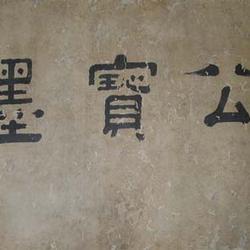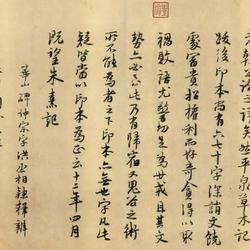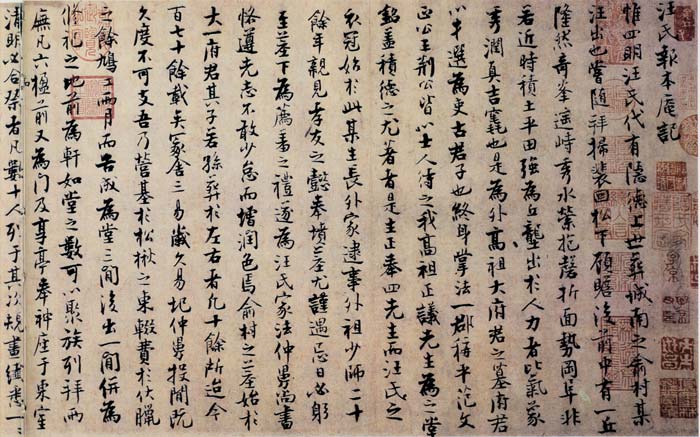
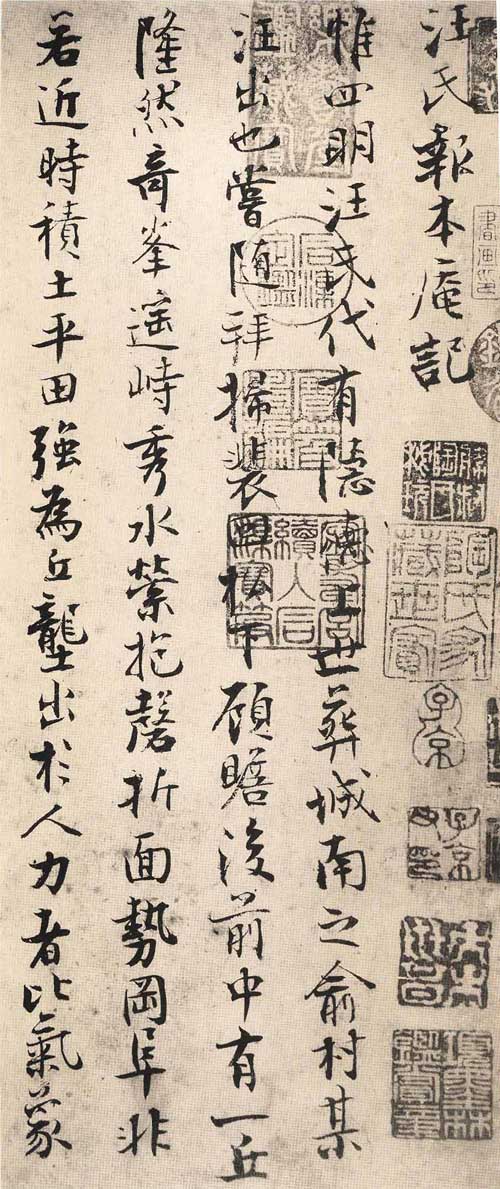
Zhang Jizhi's "Wangshi Baoben'an Ji" paper version in regular regular script, 29.3 cm in length and 91.4 cm in width. There are 38 lines of small-print running script, with 688 words. Collection of Liaoning Provincial Museum.
Behind the post are Wen Zhengming's postscript and Xiang Yuanbian's inscription. On the front and back of the volume are Xiang's seals and Bian Yongyu's ancient hall seals, as well as the seals of the Qianlong, Jiaqing and Xuantong dynasties of the Qing Dynasty. Wen Zhengming said: "According to "Huang Song Shu Lu", after the Anguo Anguo, he was able to pass on his family's learning... His calligrapher Yan Lugong was once called Gaozong. That is to say, he changed slightly but became more urgent. Then he became famous." The article "Wang's Bao Ben'an Ji" was originally written by Lou Yao. The Wang family was Lou Yao's maternal ancestor. I didn't know if he had anything to do with Zhang Jizhi, so he wanted to record this article. The paragraph "March 2, the twelfth year of Chunxi (AD 1252)" at the back of the book should have been in the text, but was dug up and moved to the end of the chapter for future generations. This volume's small-character running script is fluent and vigorous, and is more elegant than the other "Du Fu's Poems Volume" in large-scale scripts. It is a masterpiece among Zhang's handed down ink writings. During the Qianlong period, it was engraved into the fourth volume of "Mo Miaoxuan Dharma Notes".
Related instructions:
The Northern Song Dynasty suffered the humiliation of Jingkang, Bianjing fell to the Jin soldiers, and the Hui and Qin emperors were captured. Song Gaozong Zhao Gou fled south and established his capital in Lin'an. This was the Southern Song Dynasty in history, from the first year of Jianyan to the second year of Xiangxing. Years Yi Jiu accounted for one hundred and fifty-two years. Although the Southern Song Dynasty was peaceful for a while, the land south of the Yangtze River was rich in products and outstanding people. Moreover, Zhao Gouya, Emperor Gaozong of the Song Dynasty, was good at calligraphy. The "Chunhua Pavilion Notes" published in the Northern Song Dynasty gradually had a wider influence in the Southern Song Dynasty. He learned from Mi "Fu" and Huang (Valley). The trend of the two kings flourished for a while, and the calligraphy school developed greatly. "Ding Tie", "Chunxi Secret Pavilion Continuation Tie", and "Shizuotang Tie" were published one after another. Gaozong also established a calligraphy school and appointed Mi Youren as a doctor of calligraphy. Under the influence of this cultural atmosphere, many famous calligraphers appeared in the Southern Song Dynasty, such as Yue Fei, Wu Shuo, Fan Chengda, Wu Ju, Zhu Xi, Lu You, Jiang Kui, Zhang Jizhi, Wen Tianxiang, Zhao Mengjian and others. Generally speaking, the calligraphy of the Southern Song Dynasty is not as innovative and vigorous as the Northern Song Dynasty. It appears to be more conservative and more imitative. However, there are also calligraphers who are creative and individual, and Zhang Jizhi is one of the representative figures.
Zhang Jizhi was born in the 13th year of Chunxi, Xiaozong of the Southern Song Dynasty (1186), and died in the 2nd year of Xianchun, Emperor Lizong (1266). His courtesy name was Wenfu and his given name was Chuliao. He was a native of Hezhou, Anhui. He was the son of Zhang Xiaobo, a political official in the imperial family, and Zhang Xiaoxiang, a famous calligrapher in the Southern Song Dynasty, was also his uncle. When he was young, he used his father's influence to supplement the official position. He was awarded the title of Chengwu Lang. After his father's death, he was promoted to the Prime Minister of Sinong Temple and transferred to the governor of Jiaxing. Due to being framed by others, he did not take up the post. He was specially awarded the Secret Pavilion and resigned. That is to say, his official career was not smooth. According to "Li Bojia's Epitaph" It is recorded in the book that his official position was "Taizhong doctor, official in Zhimi Pavilion, founder of Liyang County, 300 households in the city, and was given a purple gold fish bag". Later, he retired at the age of 81.
Zhang Jizhi's calligraphy was influenced by his uncle Zhang Xiaoxiang when he was young. He first studied Mi Fu, and later worked hard on Chu Sui's regular script. On this basis, he combined the writing styles of Sui and Tang people to create his own calligraphy. Yige, especially his regular script, is written with freshness and vigor, and his brushwork is extremely precise and delicate. He likes to use cross strokes at the starting point of the strokes. Between the dots and drawings, he looks and looks to echo each other. He also uses cursive brushwork and is good at using square strokes to side strokes. , the posture is vivid and extremely mature. Ji Zhi's calligraphy was very famous in the Southern Song Dynasty, and the Jin people often paid high prices to buy his works. According to the "Song History Biography", "Ji Zhi was known all over the world for his calligraphy skills, and the Jin people especially treasured his calligraphy." Zhang Jizhi's regular script is characterized by its exquisiteness and maturity, just as Liang Wenshan's "Pingshu Tie" said: "Originally from Europe, with the help of Chu's method, the structure is tight, and there are many ingenuity and not square ears." In fact, small regular script is characterized by its exquisiteness and is a style in itself. Ji Ji likes to write scriptures, and there are many repeated words in the scriptures, which is difficult to write. Even if it can become its own style in regular script, it is not easy to be unique. , just like Ye Changchi's "Yu Shi." "Zhang Ji Zhi Zhi" said: "Zhang Jizhi is an abnormal person in the book. He is good at using side strokes, looking like a dwarf pine with its cover covered, whirling and cute. His brush strokes are drawn back to the vertical position, and like a long house shrinking to the ground. , So close is the potential of a thousand miles." "Zhang Jizhi Shubao Ben'an Ji" contained in this volume has "March 2, 2, the 12th year of Chunxi" at the end. According to the 12th year of Chunxi, it is 1185, and Zhang Jizhi was born in 1185. In 1986, we know that this is Bao Ben'an Ji written in the twelfth year of Chunxi, not Ji's book at this time. This book has strong regular script, exquisite stipples, vivid knotting, and flowing brushwork, which makes it appear energetic and gives people a sense of ease and ease. Judging from its mature style, it was undoubtedly written in his later years. Representative works of his life.

